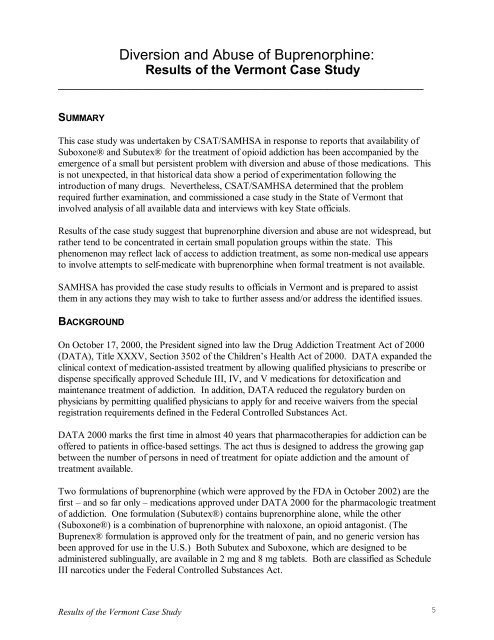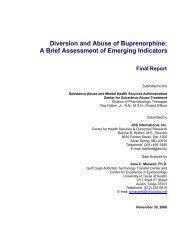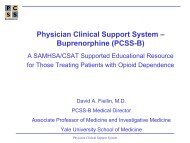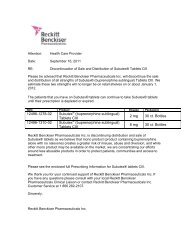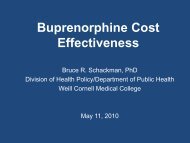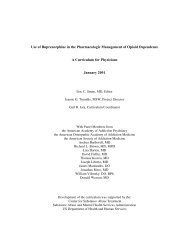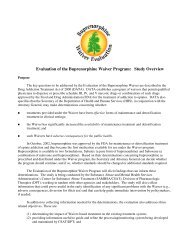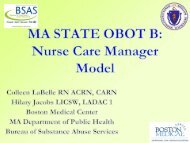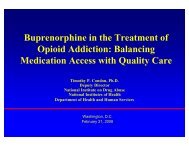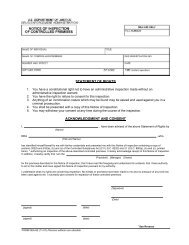Diversion and Abuse of Buprenorphine: A Brief Assessment of ...
Diversion and Abuse of Buprenorphine: A Brief Assessment of ...
Diversion and Abuse of Buprenorphine: A Brief Assessment of ...
You also want an ePaper? Increase the reach of your titles
YUMPU automatically turns print PDFs into web optimized ePapers that Google loves.
<strong>Diversion</strong> <strong>and</strong> <strong>Abuse</strong> <strong>of</strong> <strong>Buprenorphine</strong>:<br />
Results <strong>of</strong> the Vermont Case Study<br />
_________________________________________________________________<br />
SUMMARY<br />
This case study was undertaken by CSAT/SAMHSA in response to reports that availability <strong>of</strong><br />
Suboxone® <strong>and</strong> Subutex® for the treatment <strong>of</strong> opioid addiction has been accompanied by the<br />
emergence <strong>of</strong> a small but persistent problem with diversion <strong>and</strong> abuse <strong>of</strong> those medications. This<br />
is not unexpected, in that historical data show a period <strong>of</strong> experimentation following the<br />
introduction <strong>of</strong> many drugs. Nevertheless, CSAT/SAMHSA determined that the problem<br />
required further examination, <strong>and</strong> commissioned a case study in the State <strong>of</strong> Vermont that<br />
involved analysis <strong>of</strong> all available data <strong>and</strong> interviews with key State <strong>of</strong>ficials.<br />
Results <strong>of</strong> the case study suggest that buprenorphine diversion <strong>and</strong> abuse are not widespread, but<br />
rather tend to be concentrated in certain small population groups within the state. This<br />
phenomenon may reflect lack <strong>of</strong> access to addiction treatment, as some nonmedical use appears<br />
to involve attempts to selfmedicate with buprenorphine when formal treatment is not available.<br />
SAMHSA has provided the case study results to <strong>of</strong>ficials in Vermont <strong>and</strong> is prepared to assist<br />
them in any actions they may wish to take to further assess <strong>and</strong>/or address the identified issues.<br />
BACKGROUND<br />
On October 17, 2000, the President signed into law the Drug Addiction Treatment Act <strong>of</strong> 2000<br />
(DATA), Title XXXV, Section 3502 <strong>of</strong> the Children’s Health Act <strong>of</strong> 2000. DATA exp<strong>and</strong>ed the<br />
clinical context <strong>of</strong> medicationassisted treatment by allowing qualified physicians to prescribe or<br />
dispense specifically approved Schedule III, IV, <strong>and</strong> V medications for detoxification <strong>and</strong><br />
maintenance treatment <strong>of</strong> addiction. In addition, DATA reduced the regulatory burden on<br />
physicians by permitting qualified physicians to apply for <strong>and</strong> receive waivers from the special<br />
registration requirements defined in the Federal Controlled Substances Act.<br />
DATA 2000 marks the first time in almost 40 years that pharmacotherapies for addiction can be<br />
<strong>of</strong>fered to patients in <strong>of</strong>ficebased settings. The act thus is designed to address the growing gap<br />
between the number <strong>of</strong> persons in need <strong>of</strong> treatment for opiate addiction <strong>and</strong> the amount <strong>of</strong><br />
treatment available.<br />
Two formulations <strong>of</strong> buprenorphine (which were approved by the FDA in October 2002) are the<br />
first – <strong>and</strong> so far only – medications approved under DATA 2000 for the pharmacologic treatment<br />
<strong>of</strong> addiction. One formulation (Subutex®) contains buprenorphine alone, while the other<br />
(Suboxone®) is a combination <strong>of</strong> buprenorphine with naloxone, an opioid antagonist. (The<br />
Buprenex® formulation is approved only for the treatment <strong>of</strong> pain, <strong>and</strong> no generic version has<br />
been approved for use in the U.S.) Both Subutex <strong>and</strong> Suboxone, which are designed to be<br />
administered sublingually, are available in 2 mg <strong>and</strong> 8 mg tablets. Both are classified as Schedule<br />
III narcotics under the Federal Controlled Substances Act.<br />
Results <strong>of</strong> the Vermont Case Study<br />
5


